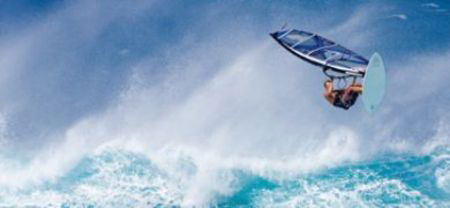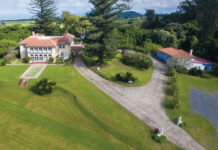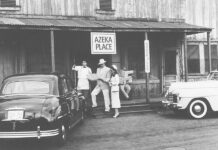Catharine Lo
 The pessimist complains about the wind; the optimist expects it to change; the realist adjusts the sails.—William Arthur Ward.
The pessimist complains about the wind; the optimist expects it to change; the realist adjusts the sails.—William Arthur Ward.
In a quiet loft a fifteen-minute drive from Maui’s Ho‘okipa Beach, Barry Spanier sits at his desk and studies the computer screen. The monitor displays a digital outline of a windsurfing rig that has multicolored wind currents trailing behind it. The paraphernalia posted on the wall behind his desk hints at his occupation: printouts with specs alongside sail blueprints, images of windsurfers charging giant waves, a photo of Easter Island, a pueo (Hawaiian owl) wing. Spanier designs windsurf sails, a highly specialized trade born from a diehard passion for sailing.
His company, Maui Sails, was an industry pioneer. Today the eight-person operation is one of half-a-dozen sail companies on this island. Spanier, who says that sail design used to be “all long sticks and pins and pencils,” now spends a lot of time clicking and dragging his mouse, specifying measurements using a computer-aided design (CAD) program. Such virtual environments are where almost all windsurf sails are designed these days.
“Now it’s so sophisticated, you can make a brand new design, and in ten days you can be testing it,” says Spanier, of a process that used to take weeks. He cups his hand around his beard and delves into a lengthy and critical discussion about the manufacturing boom in China, where the mass production of sails for the entire industry takes place—somewhere between 100,000 and 150,000 pieces a year. Maui Sails produces 4,000 sails a year, yielding $2.5 million in gross revenues and accounting for 2 to 3 percent of the total market. Spanier says they are striving to be number one.
Against big corporate competition, Maui Sails defends its industry position by appealing to a core group of dedicated customers, who pay between $375 and $1,500 for a sail. “Our niche is a sophisticated sailor who really appreciates the handling and balance,” Spanier says.
One successful strategy has been Barry’s Internet forum, where sailors can ask questions and give feedback regarding equipment, design limitations, or experimental ideas. “We can say, ‘Hey, what does everyone think of this?’ and within a week you have an answer from twenty different countries,” he says. “We’re not building our business from a big marketing base. You know, we’re guerillas. Our business is built around our product and personal relationships.”
Spanier has spent a lifetime in research and development; he started before he knew that’s what it was.
“From the time I was about eleven years old, all I did was dream about boats and sailing.” At nineteen, Spanier built his own boat, the Seminole, which carried him from his home waters of San Francisco Bay to Mexico and eventually to the shores of Lahaina in 1976. He spent a year on Maui—snorkeling, fishing, trying his first windsurfer—before wanderlust took him to Tahiti, where he built a set of sails “out in the jungle” for a friend who owned a yacht. From there, he was gone with the wind, exploring French Polynesia, Rarotonga, the Cook Islands and New Zealand.
“Every knot of the way, sailmaking was my support and my gift,” Barry remembers. “Many places, my sewing machine made clothes from flour sacks and old blankets. It made tents and covers. It generally made friends.”
When the Seminole smashed into an island and sunk, Spanier hitched a ride back to Hawai‘i. In December 1978, he and friend Geoffrey Bourne founded Spanier & Bourne Sailmakers, the precursor to Maui Sails. Ever since, Spanier has spent his career enabling other sailors to chase their own wind-driven dreams.
While the industry’s Big Three—Gaastra, Neil Pryde, and North Sails—commit months of R&D to Hawai‘i waters, Maui sailmakers have an edge. They live and work in the windsurfing capital of the world.
Nils Rosenblad, who designs sails for Naish International, cites two factors that make Maui “the perfect testing ground”: fast waves and strong winds. In Europe, where the popularity of windsurfing exploded in the eighties, the wind is usually storm-front driven, he explains. California averages wind speeds of twelve miles per hour, the U.S. East Coast nine or ten. Maui’s trades typically clock sixteen miles per hour and stronger, inviting sails to decorate the waters at Ho‘okipa as surely as rainbows follow the rain.
“If there’s any trade flow, there will be wind on Maui,” Rosenblad says. “You can hit a variety of conditions on the same day.” It also helps that no wetsuits are required, he adds with a smile.
Nils was fourteen when he began drafting boat sails. The New Jersey native took up windsurfing in St. Petersburg while studying mechanical engineering at the University of South Florida. Sailing as a semi-pro yachtsman, he arrived on Maui during in the 1983 Kenwood Cup, and moved to Maui permanently in 1985. In 2005, he joined Naish International, a core brand founded by Hawai‘i-raised world-champion windsurfer Robby Naish in 1995. Naish’s Maui operation employs a staff of sixteen.
“Sails are 100 percent about function,” states Rosenblad, who works out of Naish’s Ha‘ik¯u office. Layer sheets of extruded polyester film or laminated Mylar reinforced with Dacron across a batwing skeleton in just the right way, and you can create a wing that propels a human 74 kilometers (40 knots) an hour. That’s the world’s speed-sailing record set by French windsurfer Antoine Albeau in 2008.
Different types of sails fit different styles of sailing. Rosenblad’s personal adrenaline rush comes from wave sailing, and a wave sail, he explains, must be durable enough to handle the surf. (Windsurfers were, in fact, the first to ride the monster waves at Jaws, because the wind gave them enough speed to catch them.) A freestyle sail, on the other hand, must accelerate quickly to enable aerobatic tricks. A race sail only has to do one thing—go fast. Generally speaking, a bigger and wider sail catches more wind, and therefore greater speed, but is harder to maneuver. Sails have been designed to fit very specific preferences; while some customers look for a Toyota of a sail, others look for the Ferrari.
“The basic idea [for a new sail] can come from anywhere,” Rosenblad says. “The Redline, for example, was something that Robby [Naish] and [windsurfing product manager] Michi [Schweiger] asked for, whereas the Boxer SL was an idea I had after a few conversations with wave-sailing friends who wanted to get out in slalom conditions, but buy the absolute minimum amount of gear.”
After deciding what function the sail will have, the type of rider it suits, the style of board it should be paired with, and a target price, Rosenblad sketches conceptual designs and determines the sail’s approximate size, number of battens, cams or no cams, and other construction variables. He puts the specs into the design software, and the digital models are turned into physical prototypes in their China factory.
When the samples come in, the R&D team, composed of pro team riders and Naish staff, tests the sails on the water and offers feedback. After more fine-tuning, Rosenblad creates a template, from which he builds the rest of the sizes in the range. Further testing assures that all the different sail sizes of a particular range perform properly—“A Naish ‘Force’ must always perform and feel like a ‘Force,’” he says. It’s this attention to quality and commitment to performance that Naish customers value, and the reason the globally distributed brand ranks among the top four in most markets.
Rosenblad enjoys his loosely organized but busy days. He arrives at the office at 9 a.m., answers email, collaborates with coworkers, works on a sail design or two. The most rewarding part of the day—deadlines permitting—comes around 2 p.m. That’s when Nils takes to the water to try out his creations. “It’s part of my job. I sail most everything,” he says with a grin. “And if the waves are really, really, really good?” He ponders for a moment. “We might discover we really have to test a design.”





